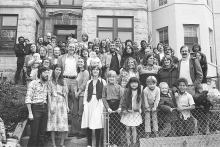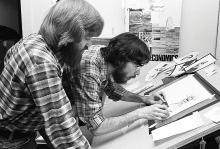The Post-American

Half a century later, a lot has changed, but we remain committed to inspiring Christians across every tradition to put their faith into action for justice and peace and strengthening faith-inspired movements for change.

WE'VE BEEN TOLD we don’t look a day over 39! Okay, old joke. But we’re acutely aware of the slightly awkward irony of an intentionally countercultural—and counterinstitutional—movement, formed in the ragtag, “don’t trust anyone over 30” culture of the early 1970s, turning 50 years old. Like the Rolling Stones, we’re still hard at it, as we mark five decades since the beginnings of Sojourners. While we’re more structured and stable than back in the early days of the so-called People’s Christian Coalition (which, not surprisingly, published many raised fists in our first few issues), we’re still doing our best to speak truth to power, afflict the comfortable, and all that. Our outward appearance may have evolved over the years, but our mission—our first principles—are unchanged from day one.
The photos below focus on the people who launched The Post-American in 1971 and helped it to thrive and grow after our 1976 move to Washington, D.C., where it became Sojourners magazine. The publication was started by students at Trinity Evangelical Divinity School in Deerfield, Ill., north of Chicago—students who were convinced that much of the church, and the evangelical part of it in particular, was wrong in its support of the Vietnam War, wrong in its approach to racism and racial justice, and at best inadequate in its awareness that the gospel calls disciples of Jesus Christ to be agents of change in our fallen world.
As you’ll see in these photos, community, worship, and public actions for social justice were all part of the job description for those who put out the magazine—there was little separation between magazine work and our socially engaged life together in Christian community. After 50 years, we’re still strong believers in an integrated life of faith and social justice, and we try to tell that story in every issue of Sojourners. We hope you enjoy this look back at our earliest roots.
—The Editors

THE NIGHT ED SPIVEY JR. first came to our Sojourners community house in Chicago, he made me laugh. He still does, more than anybody else I have ever known. But it was also evident how serious he was about his faith and its meaning for his life. Ed was raised as a Southern Baptist, and he told us a funny story of how his Baptist pastor in Chicago wanted his congregants to wear a button to work that said, “I’m Excited!” When people ask why, you were supposed to say, “I’m excited about Jesus.” But Ed was in his first job after college — as art director of the Chicago Sun-Times Sunday magazine, where he was the youngest hire in the newsroom — and he was reluctant, to say the least. While he found the button idea tacky, it was clear that he was excited about following Jesus wherever that road would lead.
That’s what we talked about at our first dinner together. Some of us were still seminary students at Trinity Evangelical Divinity School, and we had just started a new publication called The Post-American, forerunner to Sojourners. None of us had ever done a publication before, or much writing beyond leaflets and school papers. Our art director was both temporary and part-time, and we would often wait weeks before our articles were laid out for printing. It took us by surprise when, at that first dinner, Ed said that he felt a strong calling from God to join us. “I am ready to quit my job at the Sun-Times, move in with all of you, and give my life to this.” Ed’s announcement called to mind the scripture we were then reading about how the earliest disciples acted when they heard a call from Jesus.

SINCE OUR EARLIEST days publishing in tabloid format on newsprint, Sojourners (nee The Post-American) has never sought to be slick or trendy. But the magazine has always addressed timely issues, and we want our look and feel to reflect that. That means, every decade or so, we’ve engaged in a process of redesigning the visual presentation of the magazine.

I was hungry and
you blamed it on the communists
I was hungry and you
circled the moon

"Be anything you want. Be madmen, drunks, and bastards of every shape and form. But at all costs avoid one thing: success."
- Thomas Merton
As my extended family gathered around the Thanksgiving dinner table before the market crash in 2008, conversation with cousins flowed about friends making big money with technology start-ups: "more, more; faster, faster; bigger, bigger."
A hail of laughter greeted me when I quietly muttered that my ambition was, "poorer, poorer; slower, slower; smaller, smaller."
When Sojourners started in 1970, I was 23 years old. Seven young seminary students pooled $100 each and used an old typesetter that we rented for $25 a night above a noisy bar to print 20,000 copies of the first Post-American.
We took the bundles in our trucks and cars to student unions in college campuses across the country, and began collecting subscriptions in a shoebox kept in one of our rooms.
For more than a decade we lived with a common economic pot and allowed ourselves $5 a month for personal spending. The highest-paid staff person was a young woman from a neighborhood family who wanted an evening cleaning job.